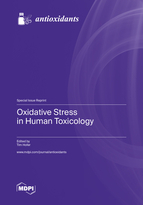Oxidative Stress in Human Toxicology
A special issue of Antioxidants (ISSN 2076-3921). This special issue belongs to the section "Health Outcomes of Antioxidants and Oxidative Stress".
Deadline for manuscript submissions: closed (30 October 2022) | Viewed by 35686
Special Issue Editor
Special Issue Information
Dear Colleagues,
This Special Issue will focus on exposure to foreign chemicals (xenobiotics) that cause oxidative stress.
Certain xenobiotics and/or their metabolites (e.g. quinones) can directly mediate formation of reactive oxygen species (ROS, e.g. peroxides) that may induce damage to biomolecules. Xenobiotics can also indirectly cause oxidative stress by affecting protective proteins (e.g. antioxidant enzymes, catalytic transition metal transporters or chelators), regulation of vitamins, antioxidants, metals, or else, disturbances that may be toxic. Experimental studies in humans and human relevant models including air-breathing mammals (e.g. rodents, dogs, sheep), extensive in vitro (e.g. human cell cultures) studies, but also studies on ‘effect biomarkers of oxidative stress’ (e.g. from lipid peroxidation or nucleic acid damage) often measured in blood or urine, are welcome. Review articles that describe new mechanisms/mode of actions/key events, e.g. full, or parts of Adverse Outcome Pathways (AOPs) related to toxicants and oxidative stress can also be submitted.
Dr. Tim Hofer
Guest Editor
Manuscript Submission Information
Manuscripts should be submitted online at www.mdpi.com by registering and logging in to this website. Once you are registered, click here to go to the submission form. Manuscripts can be submitted until the deadline. All submissions that pass pre-check are peer-reviewed. Accepted papers will be published continuously in the journal (as soon as accepted) and will be listed together on the special issue website. Research articles, review articles as well as short communications are invited. For planned papers, a title and short abstract (about 100 words) can be sent to the Editorial Office for announcement on this website.
Submitted manuscripts should not have been published previously, nor be under consideration for publication elsewhere (except conference proceedings papers). All manuscripts are thoroughly refereed through a single-blind peer-review process. A guide for authors and other relevant information for submission of manuscripts is available on the Instructions for Authors page. Antioxidants is an international peer-reviewed open access monthly journal published by MDPI.
Please visit the Instructions for Authors page before submitting a manuscript. The Article Processing Charge (APC) for publication in this open access journal is 2900 CHF (Swiss Francs). Submitted papers should be well formatted and use good English. Authors may use MDPI's English editing service prior to publication or during author revisions.
Keywords
- carbonyl
- DNA damage
- lipid peroxidation
- mitochondria
- nucleic acid
- protein oxidation
- radical
- repair
- redox cycling







